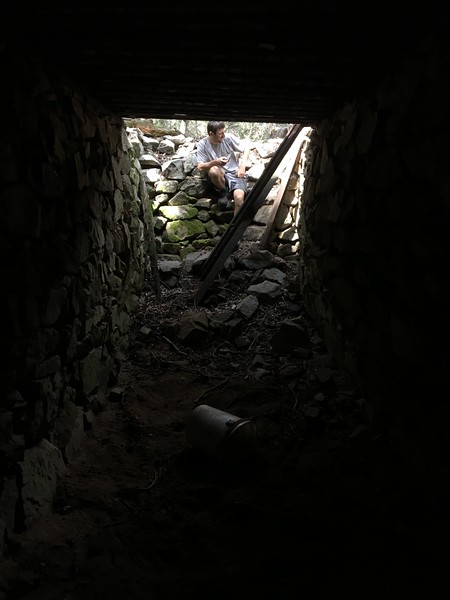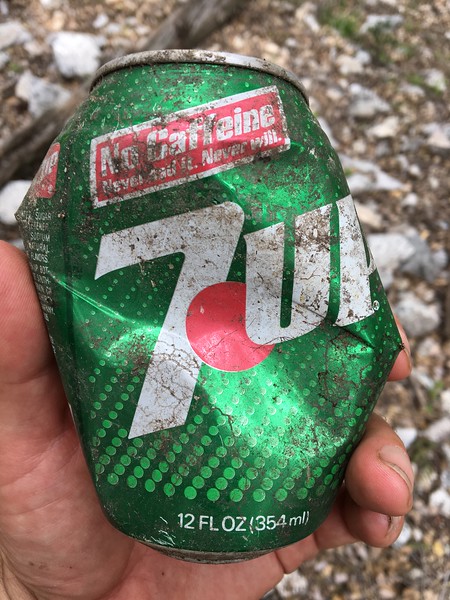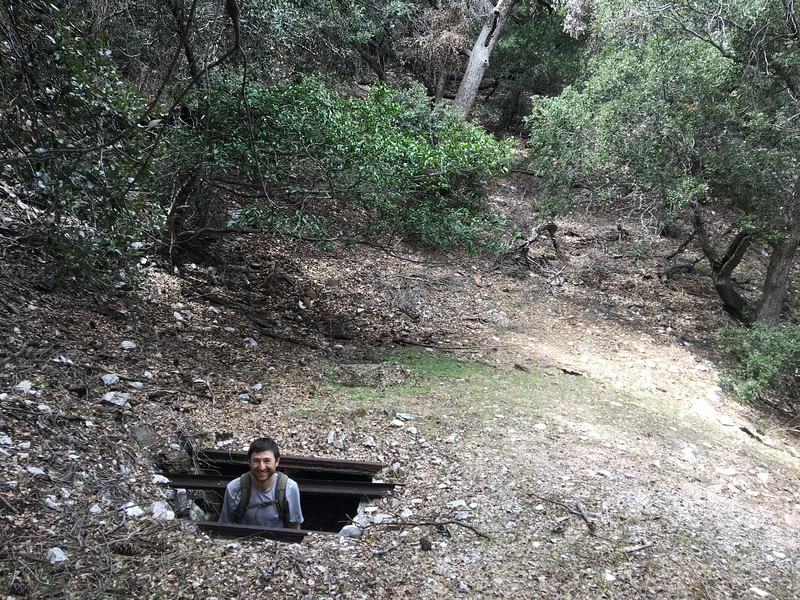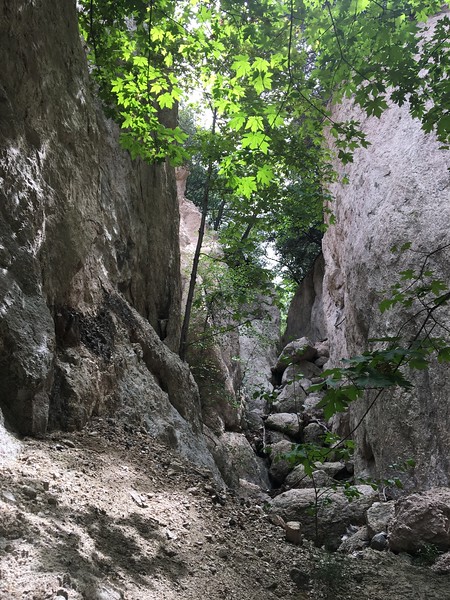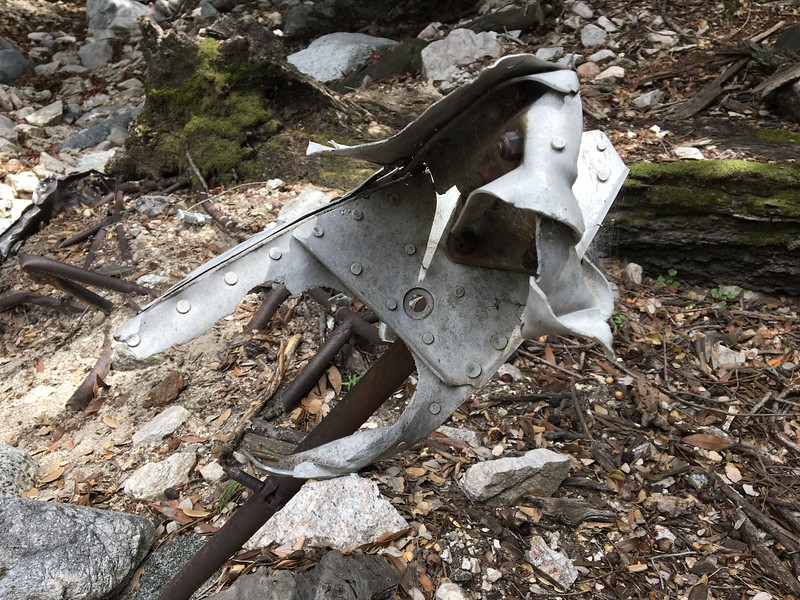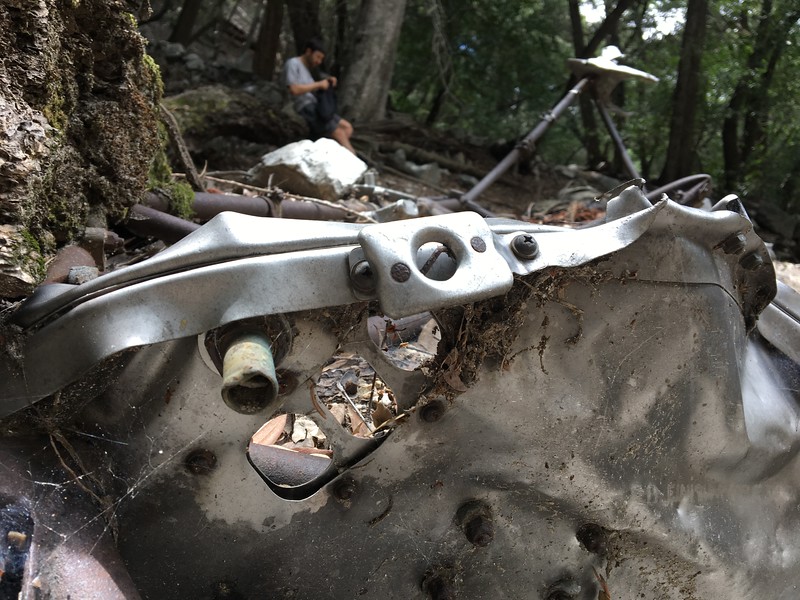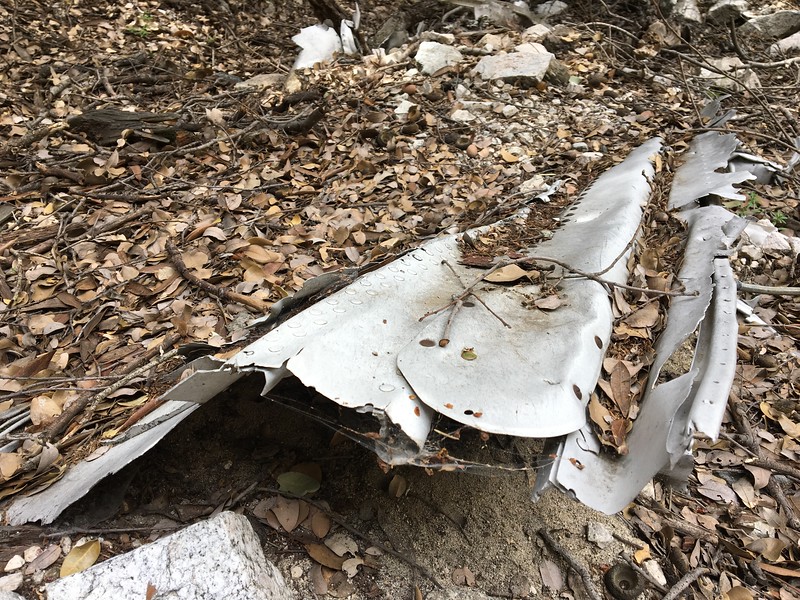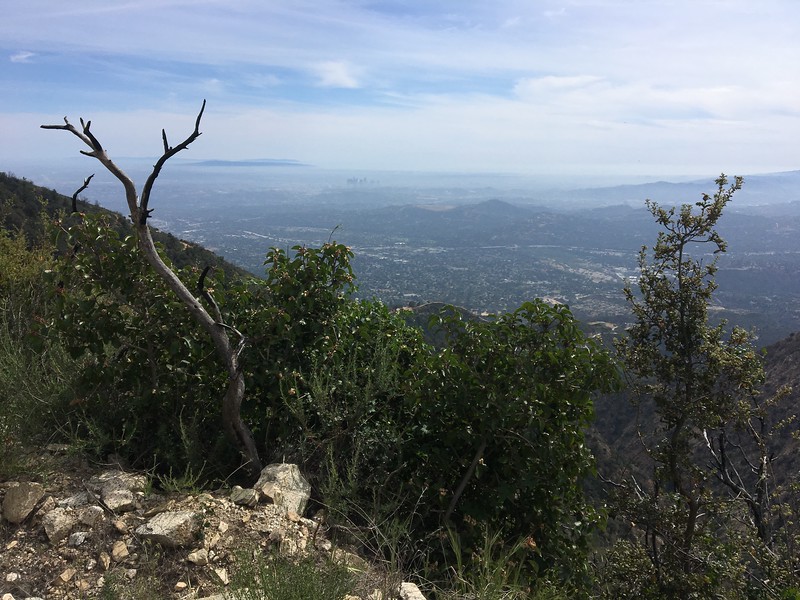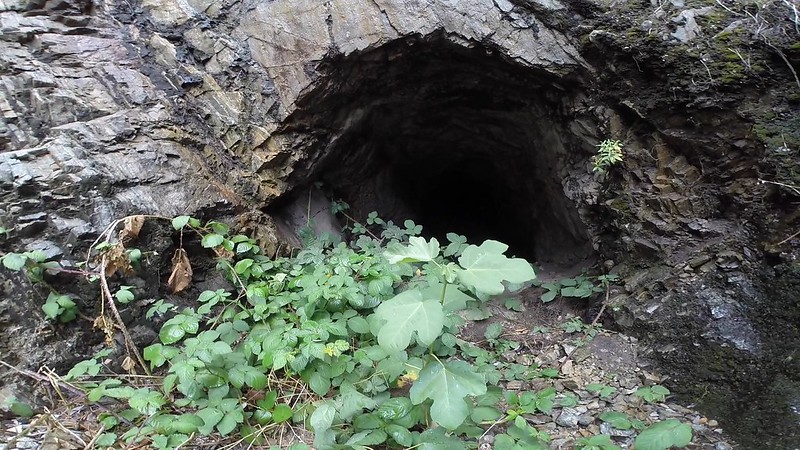Grand Canyon is grand
Posted: Sun May 06, 2018 9:44 pm
I've been on an airplane-wreck-finding kick recently, and this trip started out as another crash-site search. In 1947 an AT-6 trainer crashed somewhere below the site of the Alpine Tavern. There isn't a lot of information on the internet more detailed than that. A few trip reports ARE available, which suggest that at least some debris is present in the main channel of Grand Canyon. I've never been in Grand Canyon at all, so this sounded generally appealing. So the plan was to bike up to the Alpine Tavern site, look around for some unrelated stuff in that general area, then drop down into Grand Canyon until we hopefully would find some debris. Then from that point we'd follow the breadcrumbs into whatever side drainage contained the airplane.
TFitz and I started riding up Sunset Ridge at 7:30AM on Sunday, when the little parking lot at the gate was already full. The ride up was uneventful, and we were at Alpine Tavern shortly. Before we left I made a half-assed attempt to locate the crash site via historical aerials. This didn't work, but I did notice some sort of cabin just west of the main Alpine Tavern site that was still standing in 1960. This was at the tip of a minor ridge. The first order of business was to go find the ruins to see if there's anything still there. We bushwhacked to the site, only to find a perfectly-maintained trail coming in from a different direction when we got to the spot. Oh well. There's no cabin here anymore, but instead there's a memorial to James T. Spencer who apparently led a train-maintenance crew in this area:


The site also has supports for guy wires, and some downed power poles that presumably were held up by these guy wires at some point

Does anybody know the history here? The train was electrified; does this mean that all the buildings had power lines running to them as well? And the power lines for the train: were those running overhead? If so, was this thing I found below, in Grand Canyon, a power tower for the train?

In any case, an information panel at the Alpine Tavern site says that the hotel was abandoned in 1936 (I think; might be a bit off), and was dynamited by the forest service in 1959 to facilitate construction of the campground. This is quite puzzling since this campground doesn't really have any facilities. And I wish the original buildings were still around; even in ruined form. But that's not up to me, so the drainage below the tavern (Grand Canyon) is FULL of old detritus. In addition to old junk, there's an extensive pipe system for transporting water in and around the canyon for a LONG way below Alpine Tavern. There's a lot of piping and lots of valves, junctions and things. Anybody know what this was for? Presumably the water supply for the Alpine Tavern itself came from above. What would be the purpose of the piping below?
We dropped into the channel and started our descent. Initially the channel is dry, but quickly gets a little bit of water, which comes and goes. The flow would be better during a wetter year. The channel is generally wide, brush-free and easy to traverse, except for a small number of obstacles. Soon after we left Alpine Tavern, we encountered a number of small waterfalls that could be bypassed on our left without a lot of fuss.

These were straightforward, but we then hit a more serious obstacle: the canyon narrowed into a tight slot with vertical walls, and the ground immediately dropped off into a waterfall.

There was some accumulated deadfall between us and the lip of the slot, so it wasn't clear how tall the waterfall was, or how many tiers it had. It DID look unwise to try to descend it directly, so we found a bypass on the left. This was a good use trail that contours in a wide arc around this waterfall (that turned out to be quite large), and deposits you into the streambed below. In the process it passes near the edge of the very dramatic bowl in front of the slot, and presents a fantastic view of the falls at the mouth of Alpine Canyon (which are also here, and are BIG):

On this day it was too dry for these to work well, but mid-winter this place should be spectacular. During this bypass we noticed a flat area further up. We scrambled up expecting to see foundations and/or a chimney of an old house, but found none. There was only an old water pipe, an old valve and an odd mildly excavated area with some bricks strewn around

Weird. There were a few of these flat areas around, so we went over to the next one. There were some odd holes in the ground here. Clearly they were meant to look like this:

But they're old, and most looked like this

or even like this

This latter one had a sufficiently-broken roof so that you could descend into it:

I don't get it. Somebody did a LOT of work here, but for what purpose? Each of these grottos has an earthen floor, and walls made of stacked rocks. Some of the walls are round and some are square, but all have walls that go all the way around, with no openings. I.e. each of these is a single room. The biggest one is high enough to comfortably stand in, maybe is 6ft wide, and maybe 25ft long. The roof is salvaged rail interspersed with salvaged brick:

These are REALLY cool, and there're a number of them. But what in the world are they for? These aren't mines. Nor are they houses. Maybe they're storage for something, but what? The intact ones only have a single tiny opening in the ceiling. Water storage is the only thing that makes sense, but I can't imagine these are watertight. And what would they be storing the water for? These aren't near anything! Alpine Tavern is a ways above, along the creek bed. And the railroad was a ways above, straight up? Somebody please explain.
So anyway. While looking around, we saw an area with what looked like it could be black tubing. Above were bright-green plants, and there was what looked sorta like a campfire near it. The first thought that this was an active grow, but that didn't make much sense up here. I carefully walked up. The "black tubing" turned out to be this very snazzy and not-very-old ladder:

The plants were ferns or poison oak, that were lit up just right to look very abundant and very green. And the campfire was this:

also looking very shiny in the sun. So yeah; that was exciting. This place raised more questions than answers, so we kept going, dropped back down into the streambed, and backtracked to see the waterfall slot from the bottom:

It actually looked climbable, but the rock is terrible, and it wasn't worth the risk. The terrible-ness of the rock was evidenced by the massive exposed roots of the local trees:

We then walked to the base of the Alpine Canyon falls. The photos don't do these justice. They're awesome.

Yeah. What was this trip about, again? Oh yeah. Airplanes. We kept descending in the canyon, looking for plane parts. This required picking them out from Alpine Tavern parts, which were abundant. Eventually we found some:




It's the skeleton of the airplane (made of iron, apparently), some attached bits of aluminum skin, and some sort of wing or fuselage thing. Neat! We walked downstream a bit to see if anything else washed down. Nothing. (Or more likely, we didn't descend far enough). We then came back, and looked around some gullies directly above this area. Again, nothing. I feel like there should have been something, but there wasn't. We probably weren't in the exact right gully, or something. It's a bit odd that there weren't any breadcrumbs at all: just the above-pictured pieces in the channel bottom. Eventually we gave up, and called it a day. At some point this would be a good place to revisit, but I'm not in a hurry.
We took a slightly different route on the way back: between the road and stream. This resulted in more stuff being found. Here're more of what I think could be fallen power towers:

And some sort of collapsing retaining wall:

Apparently the concrete was poured over a bed of rocks:

Almost at the Alpine Tavern site was a drainage pipe crossing the road. Inside was a cool, LONG lizard (click on the images for the full-size originals!):



He didn't want to hang out with me, but he REALLY didn't want to be stuck in the shaded pipe. So he walked to the edge and jumped out.
And that's it. This is a really cool canyon. I now want to go back and traverse the whole thing, even though it's now missing 17 birthday balloons, not counting this festive S, and this kickass giraffe:

TFitz and I started riding up Sunset Ridge at 7:30AM on Sunday, when the little parking lot at the gate was already full. The ride up was uneventful, and we were at Alpine Tavern shortly. Before we left I made a half-assed attempt to locate the crash site via historical aerials. This didn't work, but I did notice some sort of cabin just west of the main Alpine Tavern site that was still standing in 1960. This was at the tip of a minor ridge. The first order of business was to go find the ruins to see if there's anything still there. We bushwhacked to the site, only to find a perfectly-maintained trail coming in from a different direction when we got to the spot. Oh well. There's no cabin here anymore, but instead there's a memorial to James T. Spencer who apparently led a train-maintenance crew in this area:


The site also has supports for guy wires, and some downed power poles that presumably were held up by these guy wires at some point

Does anybody know the history here? The train was electrified; does this mean that all the buildings had power lines running to them as well? And the power lines for the train: were those running overhead? If so, was this thing I found below, in Grand Canyon, a power tower for the train?

In any case, an information panel at the Alpine Tavern site says that the hotel was abandoned in 1936 (I think; might be a bit off), and was dynamited by the forest service in 1959 to facilitate construction of the campground. This is quite puzzling since this campground doesn't really have any facilities. And I wish the original buildings were still around; even in ruined form. But that's not up to me, so the drainage below the tavern (Grand Canyon) is FULL of old detritus. In addition to old junk, there's an extensive pipe system for transporting water in and around the canyon for a LONG way below Alpine Tavern. There's a lot of piping and lots of valves, junctions and things. Anybody know what this was for? Presumably the water supply for the Alpine Tavern itself came from above. What would be the purpose of the piping below?
We dropped into the channel and started our descent. Initially the channel is dry, but quickly gets a little bit of water, which comes and goes. The flow would be better during a wetter year. The channel is generally wide, brush-free and easy to traverse, except for a small number of obstacles. Soon after we left Alpine Tavern, we encountered a number of small waterfalls that could be bypassed on our left without a lot of fuss.

These were straightforward, but we then hit a more serious obstacle: the canyon narrowed into a tight slot with vertical walls, and the ground immediately dropped off into a waterfall.

There was some accumulated deadfall between us and the lip of the slot, so it wasn't clear how tall the waterfall was, or how many tiers it had. It DID look unwise to try to descend it directly, so we found a bypass on the left. This was a good use trail that contours in a wide arc around this waterfall (that turned out to be quite large), and deposits you into the streambed below. In the process it passes near the edge of the very dramatic bowl in front of the slot, and presents a fantastic view of the falls at the mouth of Alpine Canyon (which are also here, and are BIG):

On this day it was too dry for these to work well, but mid-winter this place should be spectacular. During this bypass we noticed a flat area further up. We scrambled up expecting to see foundations and/or a chimney of an old house, but found none. There was only an old water pipe, an old valve and an odd mildly excavated area with some bricks strewn around

Weird. There were a few of these flat areas around, so we went over to the next one. There were some odd holes in the ground here. Clearly they were meant to look like this:

But they're old, and most looked like this

or even like this

This latter one had a sufficiently-broken roof so that you could descend into it:

I don't get it. Somebody did a LOT of work here, but for what purpose? Each of these grottos has an earthen floor, and walls made of stacked rocks. Some of the walls are round and some are square, but all have walls that go all the way around, with no openings. I.e. each of these is a single room. The biggest one is high enough to comfortably stand in, maybe is 6ft wide, and maybe 25ft long. The roof is salvaged rail interspersed with salvaged brick:

These are REALLY cool, and there're a number of them. But what in the world are they for? These aren't mines. Nor are they houses. Maybe they're storage for something, but what? The intact ones only have a single tiny opening in the ceiling. Water storage is the only thing that makes sense, but I can't imagine these are watertight. And what would they be storing the water for? These aren't near anything! Alpine Tavern is a ways above, along the creek bed. And the railroad was a ways above, straight up? Somebody please explain.
So anyway. While looking around, we saw an area with what looked like it could be black tubing. Above were bright-green plants, and there was what looked sorta like a campfire near it. The first thought that this was an active grow, but that didn't make much sense up here. I carefully walked up. The "black tubing" turned out to be this very snazzy and not-very-old ladder:

The plants were ferns or poison oak, that were lit up just right to look very abundant and very green. And the campfire was this:

also looking very shiny in the sun. So yeah; that was exciting. This place raised more questions than answers, so we kept going, dropped back down into the streambed, and backtracked to see the waterfall slot from the bottom:

It actually looked climbable, but the rock is terrible, and it wasn't worth the risk. The terrible-ness of the rock was evidenced by the massive exposed roots of the local trees:

We then walked to the base of the Alpine Canyon falls. The photos don't do these justice. They're awesome.

Yeah. What was this trip about, again? Oh yeah. Airplanes. We kept descending in the canyon, looking for plane parts. This required picking them out from Alpine Tavern parts, which were abundant. Eventually we found some:




It's the skeleton of the airplane (made of iron, apparently), some attached bits of aluminum skin, and some sort of wing or fuselage thing. Neat! We walked downstream a bit to see if anything else washed down. Nothing. (Or more likely, we didn't descend far enough). We then came back, and looked around some gullies directly above this area. Again, nothing. I feel like there should have been something, but there wasn't. We probably weren't in the exact right gully, or something. It's a bit odd that there weren't any breadcrumbs at all: just the above-pictured pieces in the channel bottom. Eventually we gave up, and called it a day. At some point this would be a good place to revisit, but I'm not in a hurry.
We took a slightly different route on the way back: between the road and stream. This resulted in more stuff being found. Here're more of what I think could be fallen power towers:

And some sort of collapsing retaining wall:

Apparently the concrete was poured over a bed of rocks:

Almost at the Alpine Tavern site was a drainage pipe crossing the road. Inside was a cool, LONG lizard (click on the images for the full-size originals!):



He didn't want to hang out with me, but he REALLY didn't want to be stuck in the shaded pipe. So he walked to the edge and jumped out.
And that's it. This is a really cool canyon. I now want to go back and traverse the whole thing, even though it's now missing 17 birthday balloons, not counting this festive S, and this kickass giraffe:


